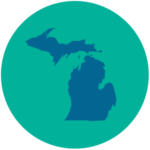RESOURCE
Fostering Social and Emotional Health through Pediatric Primary Care:
A Blueprint for Leveraging Medicaid and CHIP to Finance Change

RESOURCE
A Blueprint for Leveraging Medicaid and CHIP to Finance Change
Medicaid has a longstanding commitment to provide children access to a set of services designed to meet their unique health and developmental needs. This commitment to children is backed by the program’s Early and Periodic Screening, Diagnostic and Treatment (EPSDT) benefit package. It helps to assure that children receive a full array of preventive, developmental, dental, mental health, and specialty services in accordance with the AAP’s Bright Futures guidelines for pediatric practice.18 Medicaid’s companion program, CHIP, provides similar (although often more limited) services. A provision of federal opioid legislation signed into law in October 2018 enhances CHIP benefits for children and pregnant women, bringing them a step closer to Medicaid’s by requiring access to a range of services to address mental health and substance use disorder services.19 States can use the Medicaid and CHIP benefit requirements to encourage or require social and emotional screening, assessment, and treatment in pediatric visits.
AAP guidelines, which support the services covered under EPSDT, call for psychosocial/behavioral screening at each well-child visit from birth through age 21. This screening should address “social and emotional health, caretaker depression, and social determinants of health.”20 According to a 2018 survey of states by the National Center for Children in Poverty (NCCP), 43 states (including Washington, DC) cover social and emotional screenings for young children while eight states do not. Even in states that cover such screenings, however, pediatric providers do not always use valid and reliable screening tools or conduct screenings on a routine basis. This may be due to inadequate reimbursement, competing demands on their time, and concern that screenings will uncover problems that providers cannot address.21 States can take specific actions to reduce these barriers. For example, they can provide pediatric practices with a way to bill for the time spent on such activities and ensure that they are adequately reimbursed. As of 2018, the NCCP survey found that 23 states reported that they provide a separate code to bill for social and emotional developmental screenings, while 28 do not.22
 Minnesota has a robust initiative to screen children routinely in accordance with Bright Futures guidelines, including screenings for social and emotional development and social determinants of health. The state has developed expansive training materials on how to conduct screenings and report results to families, and also provides resources on identifying appropriate screening tools. To help ensure that pediatric care providers focus attention on social and emotional development, the state allows them to bill separately for screenings that address social and emotional concerns.26
Minnesota has a robust initiative to screen children routinely in accordance with Bright Futures guidelines, including screenings for social and emotional development and social determinants of health. The state has developed expansive training materials on how to conduct screenings and report results to families, and also provides resources on identifying appropriate screening tools. To help ensure that pediatric care providers focus attention on social and emotional development, the state allows them to bill separately for screenings that address social and emotional concerns.26
In states with managed care, the state can set standards for “care management” that include a focus on the social and emotional development of children, including requiring some services that are not considered coverable Medicaid benefits. In general, states cannot build into the capitation rates that they pay plans the cost of providing services that are not Medicaid covered benefits. Care management, however, is considered a core function of Medicaid managed care plans—even though it is not classified as a Medicaid covered benefit—and states are obligated to reimburse plans for the cost of providing it. As such, states can define their care management expectations in their contracts with managed care plans and build the cost of providing care management into their capitation rates.
Under federal requirements for care management, Medicaid managed care plans must provide beneficiaries with a designated person or entity to help navigate the health care system and coordinate care, including in different care settings and with community and social support organizations. States, however, can go beyond these minimum federal requirements. Some now require managed care organizations to routinely screen and assess patients for social and economic needs and to employ local staff to connect beneficiaries to resources. For young children, states can require managed care plans to consider the economic, social, and emotional circumstances of a family when deciding whether a child needs intensive care management services, as well as require that plans connect families to social and economic supports. For example, a state could require plans, as part of their care management obligations, to identify children at high-risk for social and emotional challenges and connect them to care across health, educational, and social domains.
 North Carolina requires Medicaid managed care plans to screen all beneficiaries (not only children) to identify whether they face interpersonal violence, are subject to toxic stress or have unmet housing, food, or transportation needs. Beneficiaries identified as “high risk” must be provided with enhanced care management services, including help addressing social and economic issues. The assistance is expected to be provided by local care managers in most instances because they have the ability to meet with families in person and have greater first-hand knowledge of community resources.
North Carolina requires Medicaid managed care plans to screen all beneficiaries (not only children) to identify whether they face interpersonal violence, are subject to toxic stress or have unmet housing, food, or transportation needs. Beneficiaries identified as “high risk” must be provided with enhanced care management services, including help addressing social and economic issues. The assistance is expected to be provided by local care managers in most instances because they have the ability to meet with families in person and have greater first-hand knowledge of community resources.
Medicaid managed care organizations must meet their contractual obligation to provide covered benefits and care management services. In addition, they can use a share of any remaining capitation funds to invest in the social and emotional development of children via “value-added” benefits. These are benefits provided by a plan that do not fit under a Medicaid benefit definition, but that could improve health outcomes and reduce costs for beneficiaries.* Some states explicitly consider a Medicaid managed care plan’s offer to provide specific value-added services when deciding whether to award the plan a contract. For example, a state could use its procurement process to require Medicaid managed care plans to describe how they will address the social and emotional development of young children, including their willingness to offer related value-added services, such as group parenting programs or the full cost of home visiting for families that otherwise might not be covered.
 Louisiana is using its Medicaid managed care procurement process to encourage plans to offer adult dental coverage, medical respite care, and a number of other value-added services. Bidders that agree to do so receive additional points in the procurement processes. Similarly, a state could award extra points for plans willing to provide parenting programs or home visiting services (to the extent not otherwise covered) to families of children at high risk for social and emotional challenges.27
Louisiana is using its Medicaid managed care procurement process to encourage plans to offer adult dental coverage, medical respite care, and a number of other value-added services. Bidders that agree to do so receive additional points in the procurement processes. Similarly, a state could award extra points for plans willing to provide parenting programs or home visiting services (to the extent not otherwise covered) to families of children at high risk for social and emotional challenges.27
* While the cost of providing value-added services is not considered when a state sets the capitation rate for Medicaid managed care plans, it still can be beneficial to plans to provide value-added benefits. Plans provide value-added benefits to attract additional members (e.g., by offering vision care); to invest in interventions that are not covered by Medicaid, but that could reduce a beneficiary’s use of medical services (e.g., short-term housing after a hospitalization to avoid a rapid return to the hospital); or to demonstrate their commitment to an issue of importance to a state.
A strong body of evidence supports the connection between a child’s health and social and emotional development and the well-being of parents and caregivers. In response, pediatric care initiatives have increasingly emphasized the importance of support for parents and caregivers.28,29 This is more feasible now that Medicaid expansion has extended coverage to many more parents with low incomes.
The opportunity to address maternal depression, a serious and widespread condition that affects both parents and their children, provides an example. CMS guidance issued in May 2016, clarified that states have the authority to cover maternal depression screening as part of a well-child visit, a best practice for pediatric primary care providers.30 The guidance explains that “a maternal depression screening can be considered an integral part of a risk assessment for the child, in light of the evidence that maternal depression can place children at risk of adverse health consequences… and state Medicaid agencies may allow such screenings to be claimed as a service for the child as part of the EPSDT benefit.” In addition, needed follow-up interventions that directly involve the parent and child together also can be billed to the child’s Medicaid.31
While states may cover maternal depression screening through either the mother’s or the child’s Medicaid, payment policies that allow the latter can increase the chance that this serious condition will be identified and addressed. Conducting such screening during the well-child visit provides an opportunity for new mothers—as many as half of whom do not receive their own postpartum visit—to discuss concerns they may have.32 The ability to bill on the child’s Medicaid is important since pediatric providers generally do not have access to the mother’s medical records. This practice also accounts for the reality that in states that have not expanded Medicaid, postpartum coverage under Medicaid typically ends 60 after days, leaving many women with low incomes uninsured. As of 2018, the NCCP survey found that 32 states (including Washington, DC) allow maternal depression screening to be billed under the child’s Medicaid; 19 states do not.33
Under Medicaid, states must cover a full range of preventive services for children, but historically, coverage of such services for adult beneficiaries has been optional. The Affordable Care Act promoted a shift in perspective: States that expand Medicaid must cover, without cost-sharing, for newly enrolled adults, all preventive services recommended given an A or B rating by the United States Preventive Services Task Force (USPSTF), and all Advisory Committee on Immunization Practices (ACIP)-recommended vaccines. Coverage of these services for the “traditional” Medicaid population remains optional. To provide an incentive for states to make preventive services available to all adults in Medicaid, states that cover all the recommended services can earn a one percentage point increase in their federal reimbursement rate for preventive services expenditures.34 While the USPSTF has had a long-standing recommendation related to screening adults, including pregnant and postpartum women, for depression, in February 2019 the task force issued a new recommendation on perinatal depression screening and gave it a B rating, making it a required service for adults enrolled under Medicaid expansions and for all adults in states that want to secure or maintain the boost in federal Medicaid matching rates. The USPSTF recommendation also describes examples of effective treatment strategies when perinatal depression is identified.35
![]()
California. The California Department of Health Care Services (DHCS) issued new guidance in Summer 2020 clarifying that family therapy is a Medi-Cal (California’s Medicaid) covered service, providing the benefit to children under age 21. To be eligible for the family therapy benefit, the child must meet one of two criteria, both of which recognize the importance of covering pediatric preventive behavioral health services: (1) up to five sessions of family therapy are covered before a mental health diagnosis is required or (2) a risk factor for mental health disorders is identified. The guidance lists possible risk factors, that include experience of discrimination, separation from a parent/ guardian due to incarceration or immigration, death of a parent/ guardian, food insecurity, housing instability, and exposure to violence or trauma. This crosswalk helps identify how the family therapy benefit can support dyadic integrated care models active in California, including HealthySteps and DULCE. The family therapy guidance was highlighted by Georgetown University’s Center for Children and Families and the First 5 Center for Children’s Policy in California. Notably, MassHealth (Massachusetts’ Medicaid) adopted a similar policy in September 2021 to permit preventive behavioral health services for children regardless if they meet criteria for behavioral health diagnosis, given the preventive nature of the benefit.

Colorado reimburses pediatric and family medicine providers for screening new mothers for depression at well-child visits under either the mother’s or child’s Medicaid. The state also covers up to six visits of short-term behavioral health services—which includes diagnostic evaluation and family psychotherapy—delivered by behavioral health clinicians such as family therapists, social workers, and psychologists in a primary care setting. This allows for integration of primary and behavioral health care, as well as the opportunity to provide family-centered care.
![]() Kansas. Effective January 1, 2021, the Kansas Department of Health and Environment (KDHE) implemented a new policy and billing guidance permitting pediatric primary care providers to screen for maternal depression as part of the EPSDT risk assessment conducted during the well-child visit. The Kansas policy provides up to three screenings during the prenatal period under the mother’s Medicaid ID and up to five screenings conducted during a pediatric well-child visit during the 12-month postpartum period under the child’s Medicaid ID. The State published a Perinatal Mental Health Toolkit as a resource for pediatric primary care providers. The value of the new screening policy was the subject of an opinion piece in the Kansas Reflector, which also highlighted the importance of extending postpartum coverage under Medicaid to ensure more mothers have access to the treatment they may need.
Kansas. Effective January 1, 2021, the Kansas Department of Health and Environment (KDHE) implemented a new policy and billing guidance permitting pediatric primary care providers to screen for maternal depression as part of the EPSDT risk assessment conducted during the well-child visit. The Kansas policy provides up to three screenings during the prenatal period under the mother’s Medicaid ID and up to five screenings conducted during a pediatric well-child visit during the 12-month postpartum period under the child’s Medicaid ID. The State published a Perinatal Mental Health Toolkit as a resource for pediatric primary care providers. The value of the new screening policy was the subject of an opinion piece in the Kansas Reflector, which also highlighted the importance of extending postpartum coverage under Medicaid to ensure more mothers have access to the treatment they may need.
States continue to look for ways to improve the quality of care provided in Medicaid, reflecting both strong federal requirements to improve quality and their own interest in ensuring that they are buying high-quality care for their substantial investments in Medicaid. Historically, however, little has been done to develop quality measures that address children’s social and emotional development. This is beginning to change, in part due to the growing recognition that these issues are critical to the long-term health and well-being of children and because of stronger federal requirements related to child health quality measures.
The Children’s Health Insurance Program Reauthorization Act of 2009 (CHIPRA) required the U.S. Department of Health and Human Services (HHS) to identify and publish a core set of children’s health quality measures for use by state Medicaid and CHIP programs. This “Child Core Set” provides an important tool for states to track and improve the quality of care provided to children with Medicaid and CHIP coverage. Although reporting has been voluntary, beginning in 2024, all states will be required to report on the full set of measures.37
The 2021 Maternal & Perinatal Health Measures for Medicaid & CHIP37 comprises 26 measures that span categories such as access to primary and preventive care, maternal and perinatal health, care of acute and chronic conditions, behavioral health, dental and oral health services, and beneficiaries’ experience of care.38 One of the current measures considers the percentage of children with Medicaid and CHIP coverage who received a developmental screening in the first three years of life, including screening related to social and emotional health. In 2017, 27 states reported a median of 40 percent of children were screened for developmental, behavioral, and social delays using a standardized tool preceding or on their first, second, or third birthday.39 Given that less than half the states are currently reporting on this measure, understanding of the national picture is incomplete at best. The requirement to report on the full set of Child Core Set measures beginning in 2024 is expected to increase states’ focus on gathering data and reporting on child health measures. It also could result in the adoption of additional measures related to the social and emotional development of children.
The National Quality Forum (NQF) convenes the multi-stakeholder Measure Applications Partnership (MAP)—specifically a Medicaid Child Workgroup within MAP—that makes recommendations annually for strengthening the Child Core Set.40 States and other stakeholders could encourage the federal government to incorporate specific measures related to social and emotional development into future versions. States also could develop their own measures that help assess progress on improving social and emotional development. For example, measures related to family experiences and changes in parenting behaviors and social circumstances as a consequence of health care received could be tracked.
The Child Core Set provides a valuable starting point for consistent quality measurement across states, and the new reporting requirements should help to improve our understanding of progress and gaps in performance and outcomes In addition to the measures contained in the Child Core Set, states may find it useful to incorporate more specific or additional measures to help advance efforts to promote social and emotional development in the pediatric care setting.
 Oregon is in the midst of a process to develop metrics that focus on the health sector’s role in achieving kindergarten readiness.41 The resulting metric or metrics are intended to be incorporated into the Oregon Medicaid’s Coordinated Care Organizations (CCOs) Incentive Measure Set, a powerful tool for encouraging CCOs to focus on the state’s child health and development priorities.
Oregon is in the midst of a process to develop metrics that focus on the health sector’s role in achieving kindergarten readiness.41 The resulting metric or metrics are intended to be incorporated into the Oregon Medicaid’s Coordinated Care Organizations (CCOs) Incentive Measure Set, a powerful tool for encouraging CCOs to focus on the state’s child health and development priorities.
Medicaid managed care states are required to facilitate a number of quality improvement activities, including developing and maintaining a managed care quality strategy and requiring plans to perform performance improvement projects (PIPs) annually. States can ensure that their quality improvement activities include a focus on pediatric care priorities, including the development of high-performing pediatric medical homes. Notably, states can include the cost of implementing these activities in the capitation rate paid to Medicaid managed care plans, and they can count expenditures on these activities in the numerator of a managed care plans’ medical loss ratio (i.e., the percentage of the premium an insurer spends on claims and expenses that improve health care quality). In addition, while most states give Medicaid managed care plans significant discretion to determine how to implement PIPs, some are becoming more directive to increase the focus on top state priorities.
 As part of the New York State First 1,000 Days on Medicaid initiative, the state is implementing a “Kids’ Quality Agenda” which requires the participation and collaboration of all Medicaid managed care plans on a two-year common PIP to improve performance on children’s and perinatal health care quality measures.42 The initial PIPs will address lead testing and follow-up, newborn hearing screening and follow-up, and developmental screening. Data collection and analysis will be underway from March 2019 through December 2020, with final reporting in July 2021.
As part of the New York State First 1,000 Days on Medicaid initiative, the state is implementing a “Kids’ Quality Agenda” which requires the participation and collaboration of all Medicaid managed care plans on a two-year common PIP to improve performance on children’s and perinatal health care quality measures.42 The initial PIPs will address lead testing and follow-up, newborn hearing screening and follow-up, and developmental screening. Data collection and analysis will be underway from March 2019 through December 2020, with final reporting in July 2021.
In Medicaid managed care states, beneficiaries must have a choice of health plans, however if beneficiaries do not make a selection, the state will auto-assign a plan. Managed care states may use their auto-assignment algorithms to provide additional inducement to plans to focus on state priorities. Currently, only nine states report that they do or will soon include quality performance in their auto-assignment algorithm.43 In creating their auto-assignment algorithms, states can take into account how well plans are integrating the promotion of social and emotional development into high-performing pediatric medical homes, creating a powerful incentive for plans to strive to perform well in this area.
 Michigan incorporates performance on quality metrics into its auto-assignment algorithms, with the Michigan Department of Health and Human Services setting quality metrics every year based on clinical performance, administrative performance, and network capacity. To date, these measures have included childhood immunization rates, well-child visits in the first 15 months of life and from three to six years, timeliness of prenatal care, and postpartum care. In future years, Michigan could elect to use measures even more directly related to the social and emotional development of children.44,45
Michigan incorporates performance on quality metrics into its auto-assignment algorithms, with the Michigan Department of Health and Human Services setting quality metrics every year based on clinical performance, administrative performance, and network capacity. To date, these measures have included childhood immunization rates, well-child visits in the first 15 months of life and from three to six years, timeliness of prenatal care, and postpartum care. In future years, Michigan could elect to use measures even more directly related to the social and emotional development of children.44,45
To reward quality outcomes and cost-efficiency in their Medicaid programs, states have been designing and implementing value-based payment (VBP) initiatives. With VBP, states are seeking to move away from reimbursing providers based on the volume of care they provide and move toward reimbursing them for improving outcomes and reducing costs. Generally, states and Medicaid managed care plans have focused their Medicaid value-based payment initiatives on adults with high-cost or chronic conditions. These efforts have not been aimed at children since, in the absence of special health care needs, most children are relatively healthy, making it unlikely that payment initiatives will generate near-term cost-savings. Moreover, many of the longer-term savings generated by upfront investments in children’s care are likely to accrue to the social service and educational sectors, a challenge known as the “wrong pocket” issue. States will need to take these challenges into account when they consider changing their current payment strategies to incentivize activities and outcomes related to children’s social and emotional development. Most importantly, they may need to place a greater priority on improved outcomes, rather than cost savings, when evaluating alternative payment strategies.46
Both managed care and fee-for-service states can increase reimbursement for care delivered in a high-performing pediatric medical home. For example, they can offer an add-on payment for pediatric providers who meet state-established standards for such medical homes either directly (in a fee-for-service state) or via a requirement on Medicaid managed care plans. Along with the “traditional” elements of a pediatric medical home (e.g., robust care coordination, engagement of families, procedures for transitioning youth to adult care, etc.), the enhanced criteria could include expectations for comprehensive developmental and behavioral screening that includes social and emotional development, parenting and family support activities, use of team-based care that includes a community health worker, integration of physical and behavioral health, linkages to social and economic supports within the community; and provider training on social and emotional development and supporting parent-child relationships.47,48
 Colorado, a fee-for-service state, provides primary care medical providers additional payments for meeting a set of clinical and structural standards, including behavioral health integration, behavioral health screening, and development of patient-centered care plans;50 and
Colorado, a fee-for-service state, provides primary care medical providers additional payments for meeting a set of clinical and structural standards, including behavioral health integration, behavioral health screening, and development of patient-centered care plans;50 and
 North Carolina will be deploying an Advanced Medical Home (AMH) model in its forthcoming Medicaid managed care program. The AMH is designed to improve primary care for children and adults alike and, as such, it includes numerous features important to the social and emotional health of children. For example, AMHs are expected to adopt a team-based approach that addresses the whole person, including food, housing, interpersonal violence/toxic stress and transportation. In its Medicaid managed care contract, North Carolina requires its plans to contract with a large majority of AMH practices in each of the regions that they serve.51
North Carolina will be deploying an Advanced Medical Home (AMH) model in its forthcoming Medicaid managed care program. The AMH is designed to improve primary care for children and adults alike and, as such, it includes numerous features important to the social and emotional health of children. For example, AMHs are expected to adopt a team-based approach that addresses the whole person, including food, housing, interpersonal violence/toxic stress and transportation. In its Medicaid managed care contract, North Carolina requires its plans to contract with a large majority of AMH practices in each of the regions that they serve.51
States with Medicaid managed care have the ability to apply incentives and withhold arrangements to encourage plans to focus on state priorities. Specifically, states can challenge plans to earn up to five percent above their capitation payments by meeting state objectives (incentive arrangement) or withhold a portion of a plan’s capitation payment pending achievement of goals (withhold arrangement). A state could ensure focus on children’s social and emotional health by tying quality incentives or withholds to performance on measures related to children’s social and emotional development. Plans can be encouraged to invest earned incentive payments to enhance services related to fostering children’s social and emotional development.52
 Since 2011, Oregon has implemented an incentive program that allows its managed care plans (referred to as “Coordinated Care Organizations”) to earn as much as 4.25 percent above their capitation payments. Each year the state assesses how well the CCOs performed on specific measures and awards incentive funds based on their performance. In recent years, child development screening has been one of the measures, and CCOs have made impressive improvements, tripling screening rates statewide from 2011 to 2017. HealthShare of Oregon, one of the State’s largest CCOs, received about $69 million in incentive payments for over 315,000 members. It reinvested these funds into parent coaching strategies, efforts to reduce disparities in developmental screening rates across cultural groups, and other child health initiatives.
Since 2011, Oregon has implemented an incentive program that allows its managed care plans (referred to as “Coordinated Care Organizations”) to earn as much as 4.25 percent above their capitation payments. Each year the state assesses how well the CCOs performed on specific measures and awards incentive funds based on their performance. In recent years, child development screening has been one of the measures, and CCOs have made impressive improvements, tripling screening rates statewide from 2011 to 2017. HealthShare of Oregon, one of the State’s largest CCOs, received about $69 million in incentive payments for over 315,000 members. It reinvested these funds into parent coaching strategies, efforts to reduce disparities in developmental screening rates across cultural groups, and other child health initiatives.
 North Carolina requires its Medicaid managed care plans to conduct a “care needs screening” that includes questions on housing, food insecurity, domestic violence, and gaps in transportation within 90 days of a beneficiary signing up with a plan. To incentivize plans to focus on these issues, North Carolina intends to link a share of the money it withholds to reward plans that have high rates of screening and referral of beneficiaries to social services.53
North Carolina requires its Medicaid managed care plans to conduct a “care needs screening” that includes questions on housing, food insecurity, domestic violence, and gaps in transportation within 90 days of a beneficiary signing up with a plan. To incentivize plans to focus on these issues, North Carolina intends to link a share of the money it withholds to reward plans that have high rates of screening and referral of beneficiaries to social services.53
As noted earlier, the use of value-based payment for children’s care requires states to take into account the unique circumstances of children, including that any broad-based, value-based payment model for children will likely need to focus more on improving outcomes rather than on generating significant short-term savings. To support the pathway to value-based payment, new payment models will require fundamental changes to care delivery, investment in infrastructure, and development of additional provider capabilities. As states continue to build their value-based payment initiatives, they have the opportunity to focus on children’s social and emotional development.54
 Virginia requires its Medicaid managed care plans to maintain and implement a VBP strategy that follows the alternate payment model (APM) framework developed by the Health Care Payment Learning and Action Network (HCP LAN).*,55 In addition, Virginia’s Medicaid managed care contract stipulates that plans must implement special medical home initiatives—currently called Medallion System Innovation Partnerships (MSIP)—that feature value-based payment arrangements with providers, performance-based incentives, and/or other incentive reforms tied to state-approved quality metrics and financial performance. Virginia’s 2017-2018 contract required that the MSIP focus on pediatric services and target pediatric populations, and that services provided through the MSIP be designed to individually coordinate Medicaid primary and acute care and mental health services.55
Virginia requires its Medicaid managed care plans to maintain and implement a VBP strategy that follows the alternate payment model (APM) framework developed by the Health Care Payment Learning and Action Network (HCP LAN).*,55 In addition, Virginia’s Medicaid managed care contract stipulates that plans must implement special medical home initiatives—currently called Medallion System Innovation Partnerships (MSIP)—that feature value-based payment arrangements with providers, performance-based incentives, and/or other incentive reforms tied to state-approved quality metrics and financial performance. Virginia’s 2017-2018 contract required that the MSIP focus on pediatric services and target pediatric populations, and that services provided through the MSIP be designed to individually coordinate Medicaid primary and acute care and mental health services.55
* The Health Care Payment Learning & Action Network (HCP LAN) is a public-private partnership created in 2015 by the US Department of Health and Human Services to implement Advanced Payment Models (APM) that drive Triple Aim enhance quality care, improve patient outcomes, and reduce costs.
States can help pediatric providers overcome some of the constraints they face in adopting practices aimed at fostering children’s social and emotional health. These include having insufficient time to spend with each patient and family, as well as needing greater knowledge and resources to identify and address families’ health-related social needs. Integrating individuals such as social workers, community health workers, or promotoras into the health care team can extend the reach of pediatric care providers and deepen trust with families. States also have the flexibility under Medicaid to allow care to be provided in home or community-based early childhood settings, as well as help finance training and pediatric practice transformation.
Medicaid reimbursement for preventive services can be used to finance expanded care teams, including community health workers. These care team members can help to conduct screenings, model healthy interactions with young children, offer parenting support and resources, provide care coordination, monitoring and follow-up, and assist families in securing food and housing assistance.58,59 State Medicaid agencies have the discretion to pay for the delivery of covered services by a Medicaid provider outside of “traditional” medical settings, including in home and early childhood settings.60
 New Mexico’s Medicaid managed care contract requires plans to engage community health workers, and has established a goal to ensure that they serve at least three percent of enrolled members.62 The community health workers are expected to provide interpretation and translation services, offer informal counseling and guidance on health behaviors, and assist people in accessing social services.
New Mexico’s Medicaid managed care contract requires plans to engage community health workers, and has established a goal to ensure that they serve at least three percent of enrolled members.62 The community health workers are expected to provide interpretation and translation services, offer informal counseling and guidance on health behaviors, and assist people in accessing social services.
 Washington State’s Medicaid agency and Early Learning Department are working together to explore the use of preventive and developmental screenings covered by Medicaid at Head Start centers, as well as strategies for sharing results with pediatric practices.63
Washington State’s Medicaid agency and Early Learning Department are working together to explore the use of preventive and developmental screenings covered by Medicaid at Head Start centers, as well as strategies for sharing results with pediatric practices.63
States have broad flexibility to require Medicaid managed care organizations to contract with pediatric providers that deploy a team-based approach. Doing so can help to ensure that family support specialists or community health workers are available to connect families to social, economic, and parenting support.
 Missouri requires Medicaid managed care plans to participate in the Local Community Care Coordination Program (LCCP), an evidence-based patient-centered concept that ensures every beneficiary has a primary care physician that leads an integrated team focused on care coordination and social needs and support referrals.64,65
Missouri requires Medicaid managed care plans to participate in the Local Community Care Coordination Program (LCCP), an evidence-based patient-centered concept that ensures every beneficiary has a primary care physician that leads an integrated team focused on care coordination and social needs and support referrals.64,65
States have broad flexibility to use Medicaid and CHIP administrative funds to improve the delivery of program services by conducting training and practice support for providers. (One key exception is that training cannot be financed with Medicaid funds if it is part of a continuing education requirement.) Medicaid administrative funds can be used, for example, to support pediatric providers in establishing or strengthening a high-performing pediatric medical home and on training related to evidence-based strategies and interventions to improve the social and emotional health of children. Medicaid administrative funds also can be used to provide outreach and training on implementing new payment policies established to support the use of such methods, such as how to operationalize new coding guidance. In addition, clinical guidelines are required to ensure that Medicaid managed care plans adopt valid and clinically reliable practice guidelines that consider the needs of their members. These provide states with a handle to require Medicaid managed care plans to ensure that providers are trained on issues such as the social and emotional development of children and trauma-informed care.
 South Carolina works in collaboration with the South Carolina Chapter of the American Academy of Pediatrics to operate the Quality Through Technology and Innovation in Pediatric Practice (QTIP). The initiative provides technical assistance and peer-learning opportunities in support of practice transformation, quality improvement, and integration of mental health services into pediatric practice.66
South Carolina works in collaboration with the South Carolina Chapter of the American Academy of Pediatrics to operate the Quality Through Technology and Innovation in Pediatric Practice (QTIP). The initiative provides technical assistance and peer-learning opportunities in support of practice transformation, quality improvement, and integration of mental health services into pediatric practice.66
 In Oregon’s procurement for Coordinated Care Organizations (CCO 2.0), the State includes a provision requiring CCOs to ensure providers are trained in trauma-informed care, implementing trauma-informed practices, and screening for adverse childhood experiences (ACEs).67
In Oregon’s procurement for Coordinated Care Organizations (CCO 2.0), the State includes a provision requiring CCOs to ensure providers are trained in trauma-informed care, implementing trauma-informed practices, and screening for adverse childhood experiences (ACEs).67
Integrating interventions targeted to social and emotional development in a health care setting is by nature cross-cutting, touching on Medicaid, maternal and child health, early intervention, and early care and education. Stakeholders in these sectors work with a common population and generally share the goal of fostering children’s healthy development. States could harness this shared focus by organizing state agencies overseeing these areas under a common governance structure and leadership. They also can reinforce a cross-cutting approach to early childhood and healthy development by incorporating relevant agencies into the same Cabinet department, building on existing State Advisory Councils on Early Childhood Care and Education or by appointing a Children’s Cabinet or Governor’s Initiative focused on a broad set of children’s needs.57
In addition, states can use strategies such as:
Using data-sharing agreements between Medicaid and other agencies, including early intervention services (i.e., early childhood intervention program Part C of IDEA), child welfare, etc.
Moving Part C into Medicaid and adding an inter-agency project manager.
For example, South Carolina moved its Part C program into its Medicaid agency to ensure stronger coordination, including through use of Medicaid claims data to identify children who would qualify for a Part C evaluation.
Leveraging state purchasing power and applying requirements to address the social and emotional health of children across coverage programs for which states are responsible (i.e., Medicaid, State employees, public educators).
A CHIP Health Services Initiative (HSI) is an activity designed to improve the health of children with low income and targets children under age 19 who are eligible for Medicaid or CHIP, although a state’s HSI may benefit all children within a state regardless of income. States can use HSIs to cover the costs of direct services or to support public health priorities, such as the operation of poison control centers or intensive lead screening promotion and lead abatement.
Under CHIP, states can use up to 10 percent of the amount they spend on health coverage for program administration and other non-coverage activities. States must prioritize administrative funding for necessary programmatic expenditures, including eligibility determinations and renewals, contract negotiations, performance measurement, and other activities to meet regulatory requirements. However, they also can use a portion of administrative funds for outreach activities to identify and enroll eligible children in the program, and for the implementation of an approved HSI. Most states have significant “room” under the 10 percent administrative cap, meaning they have spent only a small portion of the available amount. In FY 2017, for example, state expenditures on non-coverage activities averaged only 4.2 percent (see Appendix C).68
HSIs provide states flexibility and a chance to experiment. Since states are not required to execute HSIs on a statewide basis, they can identify communities or populations that might reap particular benefits from the HSI, or they can pilot new ideas and approaches to delivering quality health care. The federal matching rates for CHIP-funded activities are also advantageous to states. On average, the federal matching rates for state CHIP programs are 15 percentage points higher than the rates for Medicaid and range from 76.5 to 95.39 percent in FY 2020.69,70
In addition, federal matching rates for CHIP have been temporarily enhanced even further: through September 2019, each state’s reimbursement rate receives a boost of an additional 23 percentage points, up to a maximum of 100 percent. For this limited period, with an average enhanced federal reimbursement rate of 94 percent, the non-federal share of the cost of an HSI averages just six percent and can be as low as zero. (In 2019, 13 states receive a CHIP matching rate of 100 percent.) After September 30, 2019, the enhanced match ratchets down to an 11.5 percentage point boost through September 30, 2020, and matching rates return to the customary CHIP enhanced levels thereafter.71
A critical first step in determining the opportunity for an HSI in a state (also the first step in CMS’s review in approving HSIs) is to assess the state’s CHIP administrative funds and current spending relative to the 10 percent limit.72 Appendix B presents an analysis of states’ current CHIP allotments and spending relative to the 10 percent limit. Assuming a state has available funding, it could pursue an HSI to finance an intervention that addresses children’s social and emotional development.
 Massachusetts’ initiative to prevent youth violence through after-school programs is aimed at mitigating the consequences of trauma and promoting healthy development.73
Massachusetts’ initiative to prevent youth violence through after-school programs is aimed at mitigating the consequences of trauma and promoting healthy development.73
 Maine’s Family Home Visiting Program provides funding for community agencies to deliver home visits to first-time families and pregnant and parenting adolescents.74
Maine’s Family Home Visiting Program provides funding for community agencies to deliver home visits to first-time families and pregnant and parenting adolescents.74
 North Carolina. The North Carolina Department of Health and Human Services (NC DHHS) led the design and implementation, with stakeholders and partners, of a CHIP Health Services Initiative (HSI) State Plan Amendment (SPA) to embed early literacy promotion into the routine well-child visit for children up to age five, using the evidence-backed, American Academy of Pediatrics-endorsed Reach Out and Read model. CMS approved the SPA in October 2020, with the State securing enhanced federal matching funds of nearly 90 percent, retroactive to July 2020; federal funding over three years will be $2,400,432 with State’s share of $643,056, totaling $3,013,000. The HSI will enable Reach Out and Read to reach every county, expand the number of clinics, and begin the intervention at birth (rather than at the six-month well-child visit) bringing North Carolina’s program in line with best scientific practice on nurturing early brain development. The SPA has been featured by Georgetown University’s Center for Children and Families and in a Reach Out and Read podcast with Secretary Dr. Mandy Cohen of NC DHHS.
North Carolina. The North Carolina Department of Health and Human Services (NC DHHS) led the design and implementation, with stakeholders and partners, of a CHIP Health Services Initiative (HSI) State Plan Amendment (SPA) to embed early literacy promotion into the routine well-child visit for children up to age five, using the evidence-backed, American Academy of Pediatrics-endorsed Reach Out and Read model. CMS approved the SPA in October 2020, with the State securing enhanced federal matching funds of nearly 90 percent, retroactive to July 2020; federal funding over three years will be $2,400,432 with State’s share of $643,056, totaling $3,013,000. The HSI will enable Reach Out and Read to reach every county, expand the number of clinics, and begin the intervention at birth (rather than at the six-month well-child visit) bringing North Carolina’s program in line with best scientific practice on nurturing early brain development. The SPA has been featured by Georgetown University’s Center for Children and Families and in a Reach Out and Read podcast with Secretary Dr. Mandy Cohen of NC DHHS.
 Oklahoma’s HSI provides funds to train pediatric primary care providers to promote early literacy during well-child visits in accordance with the AAP practice recommendations. The HSI is also intended to help increase the percentage of young children attending well-child visits and improve the percentage of children receiving standardized developmental screening.75
Oklahoma’s HSI provides funds to train pediatric primary care providers to promote early literacy during well-child visits in accordance with the AAP practice recommendations. The HSI is also intended to help increase the percentage of young children attending well-child visits and improve the percentage of children receiving standardized developmental screening.75
From August 2019 to December 2020, nine states—California, Kansas, Maine, Massachusetts, New York, Nevada, North Carolina, Virginia, and Wisconsin— participated in the Pediatrics Supporting Parents Initiative State Medicaid and CHIP Implementation Workgroup. Each state formed a team that included senior Medicaid agency leadership and staff as well as the key stakeholders in their state, such as local American Academy of Pediatrics Chapter representatives, early childhood advocates, family-led organizations, Title V Directors, and local funders. The states received customized technical assistance and participated in a peer learning community aimed at helping them implement strategies identified in the Blueprint to leverage the well-child visit to improve social and emotional development of the youngest children. Over 18 months, states in the Workgroup achieved concrete state policy changes and laid the groundwork for future action and transformation. The blogs and resources below describe some of the Workgroup’s successes and lessons learned.
California | Colorado | Kansas | Louisiana | Maine | Massachusetts | Michigan | Minnesota | Missouri | New Mexico | New York | North Carolina | Oklahoma | Oregon | South Carolina | Virginia | Washington
California. The California Department of Health Care Services (DHCS) issued new guidance in Summer 2020 clarifying that family therapy is a Medi-Cal (California’s Medicaid) covered service, providing the benefit to children under age 21. To be eligible for the family therapy benefit, the child must meet one of two criteria, both of which recognize the importance of covering pediatric preventive behavioral health services: (1) up to five sessions of family therapy are covered before a mental health diagnosis is required or (2) a risk factor for mental health disorders is identified. The guidance lists possible risk factors, that include experience of discrimination, separation from a parent/ guardian due to incarceration or immigration, death of a parent/ guardian, food insecurity, housing instability, and exposure to violence or trauma. This crosswalk helps identify how the family therapy benefit can support dyadic integrated care models active in California, including HealthySteps and DULCE. The family therapy guidance was highlighted by Georgetown University’s Center for Children and Families and the First 5 Center for Children’s Policy in California. Notably, MassHealth (Massachusetts’ Medicaid) adopted a similar policy in September 2021 to permit preventive behavioral health services for children regardless if they meet criteria for behavioral health diagnosis, given the preventive nature of the benefit.

Colorado reimburses pediatric and family medicine providers for screening new mothers for depression at well-child visits under either the mother’s or child’s Medicaid. The state also covers up to six visits of short-term behavioral health services—which includes diagnostic evaluation and family psychotherapy—delivered by behavioral health clinicians such as family therapists, social workers, and psychologists in a primary care setting. This allows for integration of primary and behavioral health care, as well as the opportunity to provide family-centered care.
Colorado, a fee-for-service state, provides primary care medical providers additional payments for meeting a set of clinical and structural standards, including behavioral health integration, behavioral health screening, and development of patient-centered care plans.
Kansas. Effective January 1, 2021, the Kansas Department of Health and Environment (KDHE) implemented a new policy and billing guidance permitting pediatric primary care providers to screen for maternal depression as part of the EPSDT risk assessment conducted during the well-child visit. The Kansas policy provides up to three screenings during the prenatal period under the mother’s Medicaid ID and up to five screenings conducted during a pediatric well-child visit during the 12-month postpartum period under the child’s Medicaid ID. The State published a Perinatal Mental Health Toolkit as a resource for pediatric primary care providers. The value of the new screening policy was the subject of an opinion piece in the Kansas Reflector, which also highlighted the importance of extending postpartum coverage under Medicaid to ensure more mothers have access to the treatment they may need.

Louisiana is using its Medicaid managed care procurement process to encourage plans to offer adult dental coverage, medical respite care, and a number of other value-added services. Bidders that agree to do so receive additional points in the procurement processes. Similarly, a state could award extra points for plans willing to provide parenting programs or home visiting services (to the extent not otherwise covered) to families of children at high risk for social and emotional challenges.

Maine’s Family Home Visiting Program provides funding for community agencies to deliver home visits to first-time families and pregnant and parenting adolescents.
 Massachusetts
MassachusettsMassachusetts’ initiative to prevent youth violence through after-school programs is aimed at mitigating the consequences of trauma and promoting healthy development.
 Michigan
MichiganMichigan incorporates performance on quality metrics into its auto-assignment algorithms, with the Michigan Department of Health and Human Services setting quality metrics every year based on clinical performance, administrative performance, and network capacity. To date, these measures have included childhood immunization rates, well-child visits in the first 15 months of life and from three to six years, timeliness of prenatal care, and postpartum care. In future years, Michigan could elect to use measures even more directly related to the social and emotional development of children.
 Minnesota
MinnesotaMinnesota has a robust initiative to screen children routinely in accordance with Bright Futures guidelines, including screenings for social and emotional development and social determinants of health. The state has developed expansive training materials on how to conduct screenings and report results to families, and also provides resources on identifying appropriate screening tools. To help ensure that pediatric care providers focus attention on social and emotional development, the state allows them to bill separately for screenings that address social and emotional concerns.
 Missouri
MissouriMissouri requires Medicaid managed care plans to participate in the Local Community Care Coordination Program (LCCP), an evidence-based patient-centered concept that ensures every beneficiary has a primary care physician that leads an integrated team focused on care coordination and social needs and support referrals.
 New York
New YorkAs part of the New York State First 1,000 Days on Medicaid initiative, the state is implementing a “Kids’ Quality Agenda” which requires the participation and collaboration of all Medicaid managed care plans on a two-year common PIP to improve performance on children’s and perinatal health care quality measures.42 The initial PIPs will address lead testing and follow-up, newborn hearing screening and follow-up, and developmental screening. Data collection and analysis will be underway from March 2019 through December 2020, with final reporting in July 2021.

New Mexico’s Medicaid managed care contract requires plans to engage community health workers, and has established a goal to ensure that they serve at least three percent of enrolled members. The community health workers are expected to provide interpretation and translation services, offer informal counseling and guidance on health behaviors, and assist people in accessing social services.
 North Carolina
North CarolinaNorth Carolina requires Medicaid managed care plans to screen all beneficiaries (not only children) to identify whether they face interpersonal violence, are subject to toxic stress or have unmet housing, food, or transportation needs. Beneficiaries identified as “high risk” must be provided with enhanced care management services, including help addressing social and economic issues. The assistance is expected to be provided by local care managers in most instances because they have the ability to meet with families in person and have greater first-hand knowledge of community resources.
North Carolina will be deploying an Advanced Medical Home (AMH) model in its forthcoming Medicaid managed care program. The AMH is designed to improve primary care for children and adults alike and, as such, it includes numerous features important to the social and emotional health of children. For example, AMHs are expected to adopt a team-based approach that addresses the whole person, including food, housing, interpersonal violence/toxic stress and transportation. In its Medicaid managed care contract, North Carolina requires its plans to contract with a large majority of AMH practices in each of the regions that they serve.
North Carolina requires its Medicaid managed care plans to conduct a “care needs screening” that includes questions on housing, food insecurity, domestic violence, and gaps in transportation within 90 days of a beneficiary signing up with a plan. To incentivize plans to focus on these issues, North Carolina intends to link a share of the money it withholds to reward plans that have high rates of screening and referral of beneficiaries to social services.
North Carolina. The North Carolina Department of Health and Human Services (NC DHHS) led the design and implementation, with stakeholders and partners, of a CHIP Health Services Initiative (HSI) State Plan Amendment (SPA) to embed early literacy promotion into the routine well-child visit for children up to age five, using the evidence-backed, American Academy of Pediatrics-endorsed Reach Out and Read model. CMS approved the SPA in October 2020, with the State securing enhanced federal matching funds of nearly 90 percent, retroactive to July 2020; federal funding over three years will be $2,400,432 with State’s share of $643,056, totaling $3,013,000. The HSI will enable Reach Out and Read to reach every county, expand the number of clinics, and begin the intervention at birth (rather than at the six-month well-child visit) bringing North Carolina’s program in line with best scientific practice on nurturing early brain development. The SPA has been featured by Georgetown University’s Center for Children and Families and in a Reach Out and Read podcast with Secretary Dr. Mandy Cohen of NC DHHS.
 Oklahoma
OklahomaOklahoma’s HSI provides funds to train pediatric primary care providers to promote early literacy during well-child visits in accordance with the AAP practice recommendations. The HSI is also intended to help increase the percentage of young children attending well-child visits and improve the percentage of children receiving standardized developmental screening.
 Oregon
Oregon Oregon is in the midst of a process to develop metrics that focus on the health sector’s role in achieving kindergarten readiness. The resulting metric or metrics are intended to be incorporated into the Oregon Medicaid’s Coordinated Care Organizations (CCOs) Incentive Measure Set, a powerful tool for encouraging CCOs to focus on the state’s child health and development priorities.
Since 2011, Oregon has implemented an incentive program that allows its managed care plans (referred to as “Coordinated Care Organizations”) to earn as much as 4.25 percent above their capitation payments. Each year the state assesses how well the CCOs performed on specific measures and awards incentive funds based on their performance. In recent years, child development screening has been one of the measures, and CCOs have made impressive improvements, tripling screening rates statewide from 2011 to 2017. HealthShare of Oregon, one of the State’s largest CCOs, received about $69 million in incentive payments for over 315,000 members. It reinvested these funds into parent coaching strategies, efforts to reduce disparities in developmental screening rates across cultural groups, and other child health initiatives.
In Oregon’s procurement for Coordinated Care Organizations (CCO 2.0), the State includes a provision requiring CCOs to ensure providers are trained in trauma-informed care, implementing trauma-informed practices, and screening for adverse childhood experiences (ACEs).
 South Carolina
South CarolinaSouth Carolina works in collaboration with the South Carolina Chapter of the American Academy of Pediatrics to operate the Quality Through Technology and Innovation in Pediatric Practice (QTIP). The initiative provides technical assistance and peer-learning opportunities in support of practice transformation, quality improvement, and integration of mental health services into pediatric practice.

Virginia requires its Medicaid managed care plans to maintain and implement a VBP strategy that follows the alternate payment model (APM) framework developed by the Health Care Payment Learning and Action Network (HCP LAN). In addition, Virginia’s Medicaid managed care contract stipulates that plans must implement special medical home initiatives—currently called Medallion System Innovation Partnerships (MSIP)—that feature value-based payment arrangements with providers, performance-based incentives, and/or other incentive reforms tied to state-approved quality metrics and financial performance. Virginia’s 2017-2018 contract required that the MSIP focus on pediatric services and target pediatric populations, and that services provided through the MSIP be designed to individually coordinate Medicaid primary and acute care and mental health services.

Washington State’s Medicaid agency and Early Learning Department are working together to explore the use of preventive and developmental screenings covered by Medicaid at Head Start centers, as well as strategies for sharing results with pediatric practices.
Appendix A: Pediatrics Supporting Parents Background Information
Appendix B: Statutory And Regulatory Authorities
Appendix C: Table C1 And C2
Appendix D: Methodology
1 Harvard University, Center on the Developing Child. Brain Architecture. (2019). Retrieved from https://developingchild.harvard.edu/science/key-concepts/brain-architecture/.
2 National Research Council (US), Institute of Medicine (US) Committee on Integrating the Science of Early Childhood Development, Shonkoff, J., Phillips, D. (2000). From Neurons to Neighborhoods: The Science of Early Childhood Development. Retrieved from https://www.ncbi.nlm.nih.gov/books/NBK225557/.
3 Committee on Psychosocial Aspects of Child and Family Health, Committee on Early Childhood, Adoption, and Dependent Care, and Section on Developmental and Behavioral Pediatrics, et al. (January, 2012). Early Childhood Adversity, Toxic Stress, and the Role of the Pediatrician: Translating Developmental Science into Lifelong Health. Pediatrics, 129(1). Retrieved from https://pediatrics.aappublications.org/content/129/1/e224.
4 American Academy of Pediatrics. (2017). Bright Futures: Guidelines for Health Supervision of Infants, Children, and Adolescents. Retrieved from https://www.aap.org/en-us/Documents/periodicity_schedule.pdf.
5 Haley, J., Wang, R., Buettgens, M., Kenney, G. (2017). Health Insurance Coverage among Children Ages 3 and Younger and Their Parents: National and State Estimates. The Urban Institute. Retrieved from https://www.urban.org/research/publication/health-insurance-coverage-among-children-ages-3-and-youngerand-their-parents-national-and-state-estimates/view/full_report.
6 Centers for Medicare & Medicaid Services Medicaid/CHIP Health Care Quality Measures (2018, December). Quality of Care for Children in Medicaid and CHIP: Findings from the 2017 Child Core Set. Retrieved from https://www.medicaid.gov/medicaid/quality-of-care/downloads/performancemeasurement/2018-child-chart-pack.pdf.
7 Kaiser Family Foundation. (January, 2019). Medicaid Income Eligibility Limits for Adults as a Percent of the Federal Poverty Level. Retrieved from https://www.kff.org/health-reform/state-indicator/medicaidincome-eligibility-limits-for-adults-as-a-percent-of-the-federal-poverty-level/?currentTimeframe=0&sortModel=%7B%22colId%22:%22Location%22,%22sort%22:%22asc%22%7D.
8 Khullar, D., Chokshi, D. (2018, October). Health, Income, & Poverty: Where We Are & What Could Help. Health Affairs. Retrieved from https://www.healthaffairs.org/do/10.1377/hpb20180817.901935/full/.
9 Pittard WB III, Hulsey TC, Laditka JN, Laditka SB. School Readiness Among Children Insured by Medicaid, South Carolina. Prev Chronic Dis 2012;9:110333. Retrieved from: http://dx.doi.org/10.5888/pcd9.110333.
10 Center for Excellence for Infant and Early Childhood Mental Health Consultation. (2019). What is IECMHC. Retrieved from https://www.samhsa.gov/iecmhc/about.
11 Committee on Psychosocial Aspects of Child and Family Health. (2001, November). The New Morbidity Revisited: A Renewed Commitment to the Psychosocial Aspects of Pediatric Care. Pediatrics, 108(5). Retrieved from https://pediatrics.aappublications.org/content/108/5/1227.long.
12 American Academy of Pedatrics. (n.d.). AAP Agenda for Children: Medical Home. Retrieved from https://www.aap.org/en-us/about-the-aap/aap-facts/AAP-Agenda-for-Children-Strategic-Plan/Pages/AAPAgenda-for-Children-Strategic-Plan-Medical-Home.aspx.
13 Sulaski Wyckoff, A. (2017, February). Bright Futures: 4th Edition Includes Focus on Social Determinants of Health. American Academy of Pediatrics. Retrieved from https://www.aappublications.org/news/2017/02/17/BrightFutures021717.
14 American Academy of Family Physicians, American Academy of Pediatrics, American College of Physicians, American Osteopathic Association. (2007, March). Joint Principles of the Patient-Centered Medical Home. Retrieved from https://www.acponline.org/system/files/documents/running_practice/delivery_and_payment_models/pcmh/demonstrations/jointprinc_05_17.pdf. Fostering Social and Emotional Health through Pediatric Primary Care: A Blueprint for Leveraging Medicaid and CHIP to Finance Change June 2019 Page 54
15 Venkataramani, M., Pollack, C., & Roberts, E. (2017). Spillover Effects of Adult Medicaid Expansions on Children’s Use of Preventive Services. Pediatrics, 140(6). doi: 10.1542/peds.2017-0953.
16 Kaiser Family Foundation. (2019). Status of State Action on the Medicaid Expansion Decision. Retrieved from https://www.kff.org/health-reform/state-indicator/state-activity-around-expanding-medicaidunder-the-affordable-care-act/?currentTimeframe=0&sortModel=%7B%22colId%22:%22Location%22,%22sort%22:%22asc%22%7D.
17 Haley, J., Wang, R., Buettgens, M., Kenney, G. (2017). Health Insurance Coverage among Children Ages 3 and Younger and Their Parents: National and State Estimates. The Urban Institute. Retrieved from https://www.urban.org/research/publication/health-insurance-coverage-among-children-ages-3-and-youngerand-their-parents-national-and-state-estimates/view/full_report.
18 American Academy of Pediatrics. (2017). Bright Futures, Recommendations for Preventive Pediatric Health Care. Retrieved from https://www.aap.org/en-us/Documents/periodicity_schedule.pdf.
19 Adopted in October of 2018, the law is the Substance Use-Disorder Prevention that Promotes Opioid Recovery and Treatment for Patients and Communities (SUPPORT) Act. Public Law No: 115-271.
20 American Academy of Pediatrics. (2017). Bright Futures, Recommendations for Preventive Pediatric Health Care. Retrieved from https://www.aap.org/en-us/Documents/periodicity_schedule.pdf.
21 Weitzman, C., & Wegner, L. (2015). Promoting Optimal Development: Screening for Behavioral and Emotional Problems. Pediatrics, 135(2). doi: 10.1542/peds.2014-3716.
22 Smith, S., Granja, M.R., Hguyen, U.S., Rajani K. (2018). How States Use Medicated to Cover Key Infant and Early Childhood Services. National Center for Children in Poverty. Retrieved from http://www.nccp.org/publications/pdf/text_1211.pdf.
23 Weitzman, C., & Wegner, L. (2015). Promoting Optimal Development: Screening for Behavioral and Emotional Problems. Pediatrics, 135(2). doi: 10.1542/peds.2014-3716.
24 Council on Children with Disabilities, Section on Developmental Behavioral Pediatrics, Bright Futures Steering Committee, Medical Home Initiatives for Children with Special Needs Project Advisory Committee. (2006, July). Identifying Infants and Young Children with Developmental Disorders in the Medical Home: An Algorithm for Developmental Surveillance and Screening. Pediatrics, 118(1). Retrieved from https://pediatrics.aappublications.org/content/118/1/405.full.
25 US Department of Health and Human Services (2014, March). Birth to 5: Watch Me Thrive! A Compendium of Screening Measures for Young Children. Retrieved from https://helpmegrownational.org/wp-content/uploads/2018/03/screening_compendium_march2014.pdf.
26 Minnesota Department of Human Services (2019, January 15). Child and Teen Checkups.
Retrieved from http://www.dhs.state.mn.us/main/idcplg?IdcService=GET_DYNAMIC_CONVERSION&RevisionSelectionMethod=LatestReleased&dDocName=dhs16_150092#develop.
27 Louisiana Department of Health. (2010). Request for Proposals for Louisiana Medicaid Managed Care Organizations. Retrieved from http://ldh.la.gov/assets/medicaid/RFP_Documents/RFP3/MCO_RFP.pdf.
28 Thompson, R. (2018, April). Social-Emotional Development in the First Three Years. Robert Wood Johnson Foundaiton. Retrieved from https://www.rwjf.org/en/library/research/2018/04/social-emotionaldevelopment-in-the-first-three-years.html.
29 Center for Children and Families. (2017, March). Health Coverage for Parents and Caregivers Helps Children. Georgetown University Health Policy Institute. Retrieved from https://ccf.georgetown.edu/wpcontent/uploads/2017/03/Covering-Parents-v2.pdf.
30 Centers for Medicare & Medicaid Services. (2016, May 11). Informational Bulletin: Maternal Depression Screening and Treatment: A Critical Role for Medicaid in the Care of Mothers and Children. Retrieved from https://www.medicaid.gov/federal-policy-guidance/downloads/cib051116.pdf. Fostering Social and Emotional Health through Pediatric Primary Care: A Blueprint for Leveraging Medicaid and CHIP to Finance Change June 2019 Page 55
31 Centers for Medicare & Medicaid Services. (2016, May 11). Informational Bulletin: Maternal Depression Screening and Treatment: A Critical Role for Medicaid in the Care of Mothers and Children. Retrieved from https://www.medicaid.gov/federal-policy-guidance/downloads/cib051116.pdf.
32 Masho, S., Cha, S., Karjane, N., McGee, E., Charles, R., Hines, L., Kornstein, S. (2018, June). Correlates of
Postpartum Visits Among Medicaid Recipients: An Analysis Using Claims Data from a Managed Care Organization. J Womens Health, 27(6):836-43. doi: 10.1089/jwh.2016.6137.
33 Smith, S., Granja, M.R., Hguyen, U.S., Rajani K. (2018). How States Use Medicated to Cover Key Infant and Early Childhood Services. National Center for Children in Poverty. Retrieved from http://www.nccp.org/publications/pdf/text_1211.pdf.
34 Centers for Medicare & Medicaid Services. (2013, February). State Medicaid Director: Affordable Care Act Section 4106 (Preventative Services). Retrieved from https://www.medicaid.gov/federal-policy-guidance/downloads/smd-13-002.pdf.
35 US Preventive Services Task Force (2019, February). Interventions to Prevent Perinatal Depression: US Preventive Services Task Force Recommendation Statement. JAMA, 321(6):580-87. doi: 10.1001/jama.2019.0007.
36 Colorado Department of Health Care Policy & Financing (2018, June). Short-term Behavioral Health Services in the Primary Care Setting. Retrieved from https://www.colorado.gov/pacific/sites/default/files/Short-term%20Behavioral%20Health%20Services%20in%20Primary%20Care%20Fact%20Sheet%20June%202018.pdf.
37 2021 Maternal & Perinatal Health Measures for Medicaid & CHIP https://www.medicaid.gov/medicaid/quality-of-care/downloads/2021-maternity-core-set.pdf.
38 Centers for Medicare & Medicaid Services. (2018, December). Quality of Care for Children in Medicaid and CHIP: Findings from the 2017 Child Core Set. Retrieved from https://www.medicaid.gov/medicaid/qualityof-care/downloads/performance-measurement/2018-child-chart-pack.pdf.
39 Centers for Medicare & Medicaid Services. (2018, December). Quality of Care for Children in Medicaid and CHIP: Findings from the 2017 Child Core Set. Retrieved from https://www.medicaid.gov/medicaid/qualityof-care/downloads/performance-measurement/2018-child-chart-pack.pdf.
40 National Quality Forum, Measure Applications Partnership Medicaid Adult and Child Workgroups. (2018, August). Strengthening the Core Set of Healthcare Quality Measures for Children Enrolled in Medicaid and Chip, 2018. Retrieved from http://www.qualityforum.org/Publications/2018/08/Strengthening_the_Core_Set_of_Healthcare_Quality_Measures_for_Children_Enrolled_in_Medicaid_and_CHIP,_2018.aspx.
41 Oregon Health Authority, Office of Health Analytics. (n.d.). Health Aspects of Kindergarten Readiness Technical Workgroup. Retrieved from https://www.oregon.gov/oha/HPA/ANALYTICS/Pages/KR-Health.aspx.
42 Kaiser Family Foundation (2018). Medicaid Managed Care Quality Initiatives. Retrieved from https://www.kff.org/medicaid/state-indicator/medicaid-managed-care-quality-initiatives/?currentTimeframe=0&sortModel=%7B%22colId%22:%22Location%22,%22sort%22:%22asc%22%7D.
43 Kaiser Family Foundation. (2019). Status of State Action on the Medicaid Expansion Decision. Retrieved from https://www.kff.org/health-reform/state-indicator/state-activity-around-expanding-medicaidunder-the-affordable-care-act/?currentTimeframe=0&sortModel=%7B%22colId%22:%22Location%22,%22sort%22:%22asc%22%7D.
44 State of Michigan. (2018). Comprehensive Health Care Program for the Michigan Department of Health and Human Services. Retrieved from https://www.michigan.gov/documents/contract_7696_7.pdf.
45 California Health Care Foundation. (2006). Putting Quality to Work: Rewarding Plan Performance in Medi-Cal Managed Care, Appendix B. Retrieved from https://www.chcf.org/wp-content/uploads/2017/12/PDFPuttingQualityToWorkAppendixB.pdf. Fostering Social and Emotional Health through Pediatric Primary Care: A Blueprint for Leveraging Medicaid and CHIP to Finance Change June 2019 Page 56
46 Bailit Health. (July 2016). Value-Based Payment Models for Medicaid Child Health Services. United Hospital Fund. Retrieved from https://uhfnyc.org/publications/publication/value-based-payment-models-formedicaid-child-health-services/.
47 Garner A.S., Shonkoff, J.P., et al. (2012). Early Childhood Adversity, Toxic Stress, and the Role of the Pediatrician: Translating Development Science into Lifelong Health. Pediatrics, 129. doi: 10.1542/peds.2011-2662.
48 Johnson, K. & Bruner, C. (2018, October). A Sourcebook on Medicaid’s Role in Early Childhood: Advancing High Performing Medical Homes and Improving Lifelong Health. Child and Family Policy Center. Retrieved from https://www.cfpciowa.org/documents/filelibrary/medicaid_finance/section_pdfs/Introduction_8D6E8F3FB002C.pdf.
49 Roby, D. H., & Jones, E. E. (2016). Limits on same-day billing in Medicaid hinders integration of behavioral health into the medical home model. Psychological Services, 13(1), 110-119. http://dx.doi.org/10.1037/ser0000044.
50 Colorado Department of Health Care Policy & Financing. (2017, January). Enhanced Primary Care Medical Provider Program Fact Sheet. Retrieved from https://www.colorado.gov/pacific/sites/default/files/Enhanced%20Primary%20Care%20Medical%20Proivder%20Definitions.pdf.
51 North Carolina Department of Health and Human Services, Division of Health Benefits. (2018, December). Programmatic Guidance on PHP Contracting Requirements for Tier 3 AMH Practices. Retrieved from https://files.nc.gov/ncdma/documents/Providers/Programs_Services/amh/AMH_Programmatic_Guidance_Contracting_12.17.18.pdf.
52 North Carolina Department of Health and Human Services (2018, August). Request for Proposal for Medicaid Managed Care Prepaid Health Plan. Retrieved from https://www.ncdhhs.gov/requestinformation.
53 North Carolina Department of Health and Human Services. (2018, March). North Carolina’s Medicaid Managed Care Quality Strategy. Retrieved from https://files.nc.gov/ncdhhs/documents/DRAFT_QualityStrategy_20180320.pdf.
54 New York Department of Health. (February, 2019). Children’s Value Based Payment Quality Measure Set, Measurement Year 2019. Retrieved from https://www.health.ny.gov/health_care/medicaid/redesign/dsrip/vbp_library/quality_measures/2019/docs/childrens_qms.pdf.
55 Health Care Payment Learning & Action Network. (July, 2017). Alternative Payment Model Framework. Retrieved from https://hcp-lan.org/.
56 Virginia Department of Medical Assistance Services. (2018, July). Medallion 4.0 Medicaid Managed Care Contract. Retrieved from http://www.dmas.virginia.gov/files/links/1566/Medallion%204.0%20Contract%20(07.26.2018).pdf.
57 U.S. Department of Health & Human Services. (2017, July). State Advisory Councils on Early Childhood Education and Care. Retrieved from https://www.acf.hhs.gov/ecd/early-learning/state-advisory-councils.
58 Centers for Medicare & Medicaid Services. (2013, November 27). Information Bulletin: Update on Preventive Services Initiatives. Retrieved from https://www.medicaid.gov/federal-policy-guidance/downloads/cib-11-27-2013-prevention.pdf.
59 Snyder, J.E. (2016, January). Assistant Secretary for Planning and Evaluation Issue Brief: Community Health Workers: Roles and Opportunities in Health Care Delivery System Reform. United States Department of Health and Human Services. Retrieved from https://aspe.hhs.gov/system/files/pdf/168956/CHWPolicy.pdf.
60 Rosenbaum, S., Proser, M., et al. (2001). Room to Group: Promoting Child Development through Medicaid and CHIP. Commonwealth Fund. Retrieved from https://www.commonwealthfund.org/sites/default/files/documents/___media_files_publiations_fund_report_2001_jun_room_to_grow__promoting_child_development_through_medicaid_and_chip_rosenbaum_room_451_pdf.pdf. Fostering Social and Emotional Health through Pediatric Primary Care: A Blueprint for Leveraging Medicaid and CHIP to Finance Change June 2019 Page 57
61 Delaware Health and Social Services Division of Public Health, Delaware Center for Health Innovation, Health Management Associates. (2017, June). Development and Deployment of Community Health Workers in Delaware: Establishing a Certification Program and Reimbursement Mechanism. Retrieved from https://www.dhss.delaware.gov/dph/hsm/files/dechwreport.pdf.
62 New Mexico Human Services Department. (n.d.). Medicaid Managed Care Services Agreement. Retrieved from http://www.hsd.state.nm.us/uploads/files/Looking%20For%20Information/General%20Information/Contracts/Medical%20Assistance%20Division/MCO’s%20Centennial%20Care%202.0/BCBS%20Contract%20PSC%2018-630-8000-0033%20A1.pdf.
63 Shuell, J., Steinberg, A., et al. (2018). Early Childhood and Medicaid: Opportunities for Partnering. Nemours Children’s Health System. Retrieved from http://www.movinghealthcareupstream.org/wp-content/uploads/2018/11/23421_Nem_EarlyChildhdMedcdRept_RevFINAL.pdf.
64 Missouri Department of Social Services, MO HealthNet Division. (2017, May 1). Managed Care Contract Approved on July 19, 2018. Retrieved from https://dss.mo.gov/business-processes/managed-care/docs/Managed-Care-Contract-Approved.docx.
65 Gifford, K., et al. (2018, October). States Focus on Quality and Outcomes Amid Waiver Changes: Results from a 50-State Medicaid Budget Survey for State Fiscal Years 2018 and 2019. Kaiser Family Foundation. Retrieved from https://www.kff.org/report-section/states-focus-on-quality-and-outcomes-amid-waiverchanges-managed-care-initiatives/.
66 South Carolina Department of Health and Human Services. (n.d.). South Carolina Healthy Connections Medicaid, Quality Through Technology and Innovation in Pediatrics (QTIP). Retrieved from https://msp.scdhhs.gov/qtip/.
67 Oregon Health Authority. (n.d.). Oregon Health Plan Health Plan Services Contract: Coordinate Care Organization, 2020. Retrieved from https://www.oregon.gov/oha/OHPB/CCODocuments/03-CCO-RFA-4690-0-Appendix-B-Sample-Contract-Final.pdf.
68 MACPAC. (2017). Exhibit 33: CHIP Spending by State. Retrieved from https://www.macpac.gov/publication/chip-spending-by-state/.
69 Centers for Medicare & Medicaid Services. (n.d.). CHIP Financing. Retrieved from https://www.medicaid.gov/chip/financing/index.html.
70 Kaiser Family Foundation. (2018, November). Enhanced Federal Matching Assitance Percentage (FMAP) for CHIP. Retrieved from https://www.kff.org/other/state-indicator/enhanced-federal-matching-rate-chip/?currentTimeframe=0&sortModel=%7B%22colId%22:%22Location%22,%22sort%22:%22asc%22%7D.
71 Centers for Medicare & Medicaid Services. (n.d.). CHIP Financing. Retrieved from https://www.medicaid.gov/chip/financing/index.html.
72 Centers for Medicare & Medicaid Services. (2017, January 12). Frequently Asked Questions (FAQs): Health
Services Initiative. Retrieved from https://www.medicaid.gov/federal-policy-guidance/downloads/faq11217.pdf.
73 Massachusetts Department of Public Health. (n.d.). Youth Violence Prevention Through Positive Youth Development. Retrieved from https://www.mass.gov/service-details/youth-violence-prevention-throughpositive-youth-development.
74 Maine Center for Disease Control & Prevention. (n.d.). Maine Families Home Visiting. Retrieved from https://www.maine.gov/dhhs/mecdc/health-equity/hv/index.shtml.
75 Oklahoma Health Care Authority. (2018, October 31). Press Release: Reach Out and Read Coming to More SoonerCare Members. Retrieved from http://www.okhca.org/about.aspx?id=22619.
76 Centers for Medicaid & Medicaid Services. (2015, July). Questions and Answers: Administrative Claiming Related to Training and Registry Costs. Retrieved from https://www.medicaid.gov/medicaid/finance/downloads/qa-training-registry-costs-071015.pdf.